It is August 1st, sometime after midnight. Not a single set of eyes is fixated to the small television situated in middle of our living room — except for mine. There I sit in a sea of people who have come not for the reason not which I am here. Frank Ocean and I are having a staring contest; I’ll be damned if I blink first.
An hour passes as I give myself to this idle fantasy, unable to accept that which has been accepted by every other person occupying this space of celebration and glee: the album is not coming. Quickly arrives the time of the night when people should leave. The host should play that one Semisonic song where everyone sings the refrain asking them to leave then immediately following the song ask if they actually have to leave. Tonight, I opt for ‘Thinkin Bout You’, the melancholic chart topper from Ocean’s debut album. Tonight, I don’t want people to leave. Tonight, I want them to stay. This is no longer a party, it is a vigil.
It is almost three weeks later when I receive the text from my friend, “Frank dropped.” It had to be then. Near days after saying goodbye to someone important. At a pivot in my life where I could feel myself sliding off the fulcrum, of course Frank dropped.
Going into both albums, it is quintessential that you block out that this release took four years collectively. One cannot deny that Ocean’s antics were frustrating at times, but if you go into this album thinking that an artist was capable of not only reproducing, but also improving upon, an album as addictive as Channel Orange, you’re going to rob yourself of an optimal listening experience.
To best enjoy these releases, you have to take them for what they are. That being Frank Ocean once again exposing himself to us through music. These projects are meant to heal in the same way group therapy does. Ocean makes himself vulnerable as he dances his way through two full-length albums giving us the rawest, most naked form of himself.
This is what makes a great song/album/artist to me. The ability to consistently excavate a feeling from within me. When I hear Kendrick, I feel empowered. When I hear Chance, I feel joyous. But there is absolutely no artist on this planet that can make me feel more nostalgic than Frank. For almost ten years Frank has been making us remember what it smelled like when we first fell in love. Or what flavored chapstick heartbreak tastes like. Ever since the Lonny Breaux collection, Ocean has been dousing us with nostalgia. Songs such a Novacane, which can be found on Ocean’s aptly named mixtape, “Nostalgia, Ultra”, make the listener devastatingly reminiscent. In the middle of this sexual endeavor while on drugs, Ocean takes the time to point out, “been tryna film pleasure with my eyes wide shut but it keeps on movin’.” It is an incredible talent he has, to make even the most blissful of moments terribly sad.
That’s what these albums are, a collection of moments in which Frank has transformed his decomposed tragedies into those flowers that remind us of our first love. That’s why this music is great. Life and music are so intertwined, that we don’t even have to allow ourselves to, our mind just melds the two together naturally. We remember the moments and we remember the music that accompanied those moments.
That’s why I am not worried that this project took Frank Ocean four years. Or that it might not be as great of an album as its predecessor. Because when the rhythmic mantra of Comme Des Garcons hits me years from now, when I least expect it, I know I will be transported back to summer; a summer of fruition and incautious at its crest and unforgiving loneliness at its troughs. When I hear Self Control, I will be taken back to that first night under the stars. Because that’s what the best music is for us: a teleportation device.
- It will interest you whether you are looking for real NFL analysis, fantasy football analysis, or both.
- It shows using real data that running backs perform differently based on their contract status.
- I can – and will – apply this same analysis to each position group on the field.
Introduction
It’s common to see ‘player entering a contract year’ as a reason to predict a higher performance level on the field. I’ve seen it for every position from time to time, but especially for running backs.
I have yet to see real data on the subject, and that’s what I’m going for here. Time to put on your *nerd alert* statistical caps.
Hypothesis
Contract year players try harder. They stay on the field more and they do more with the ball.
Once they get a contract, players get lazy. They don’t try as hard in the offseason or during the season, meaning they are more injury prone and are less effective with the ball.
Good old-fashioned human nature.
Sample Size
Note: if you are a casual fan and just want to see the results, feel free to skip this section and go straight to “Results”. This section is more for the math gurus out there so that they can understand (and poke holes in) my logic and statistical reasoning :).
Unlike baseball, which provides a borderline-unlimited amount of statistically significant data, you often have to be some combination of creative, shrewd, and bold with data analysis in the NFL. There just aren’t that many games and plays in a given football season.
I wanted to see how NFL running backs performed in these three areas:
- The years leading up to their contract year (at least two, preferably three or four)
- Their contract year
- The year immediately after their contract year
These three defined periods of performance sound nice and all, but they raise several questions, such as: What age and years of experience for RBs are we going to use? What about players who were undrafted or were traded? What about players who sign extensions while still under contract? And what about injuries?
And with these questions come my set of assumptions to narrow this down:
We are only looking at drafted RBs during their rookie contracts
By limiting our data to rookie contracts of drafted players, we remove any issues of declining performance due to age. We also get rid of undrafted players who only had a very short contract (2 or 3 year deal) at first (such as Arian Foster) as well as players who were traded in the middle of their original contracts (such as Chris Ivory and Reggie Bush). By using these limitations, we can look at a set of players who have the three phases of performance I defined above (2-4 years leading up to contract year; contract year itself; and year after contract year).
Players who sign an extension while still under their rookie contract are included
If a player signs a new contract in the offseason after their rookie contract was completed, then their contract year was the final year of their rookie contract. Simple enough.
If a player signs a contract extension in the offseason prior to the final year of their rookie contract, then that player’s contract year was the second to last year of their rookie deal. Not quite as simple, but still easy enough to get behind, because contract negotiations in the NFL take a long time – on the order of months. They can even take over a year – that’s why some of the top players end up playing out seasons under the franchise tag. The thinking is that, if a player signs an extension during the offseason (even if they are still under contract for the upcoming season), odds are that 1) negotiations were ongoing for a long time prior, and 2) the player knew it.
For example, take LeSean McCoy, who signed a large extension with the Eagles the offseason prior to the final year of his rookie deal. You better believe that his agent was working on that contract for months prior – and you better believe that McCoy knew it (and had appropriate motivation).
Injuries are included
Running backs are among the most injured players in football, so trying to exclude injuries from this data set would have reduced it to zero. As it happens, I think that including injuries is actually critical to this data set – going along with our hypothesis, a more motivated player will spend more time on strength, conditioning, and flexibility during the offseason, and will, in the long run, be less injury prone. Conversely, a fat and happy player with a new contract might be lazier and thus will be more prone to injury.
Only players with significant contracts (roughly $2.5 million annually or greater) are included
We are focusing on financial effects, so looking at players with the biggest financial upticks makes sense.
Relatively underutilized players are not included
Guys like Michael Turner, Darren Sproles, and James Starks aren’t worth looking at because they weren’t given a consistent, featured role under their rookie deals.
We’ll look at players who were drafted within the last 10 years
If someone wants to pay me to crunch numbers back to 1970, I’m listening. Until then…
Results
Using the assumptions and scope limitations above, we have 13 players who meet the criteria:
Adrian Peterson (MIN), LeSean McCoy (PHI), Jonathan Stewart (CAR), Jamaal Charles (KC), DeMarco Murray (DAL), Shane Vereen (NE), Matt Forte (CHI), C.J. Spiller (BUF), Mark Ingram (NO), Ryan Mathews (SD), DeAngelo Williams (CAR), Chris Johnson (TEN), Ray Rice (BAL).
In the table below,
- “Pre-CY Avg” represents a player’s average statistics over their rookie contract, leading up to their contract year.
- “CY” represents a player’s statistics during their contract year.
- “CY+1” represents a player’s statistics the season immediately after signing their contract.
Drum roll please…
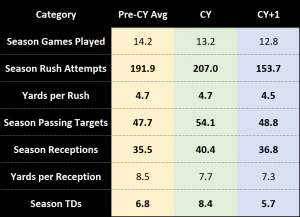
Wow.
I’ll be honest – I didn’t think the results would be this telling.
I also feel like I barely even need to discuss these results, as they speak for themselves.
=> The difference in rushing attempts is simply staggering. After averaging 192 carries per season, contract-year RBs get 207 carries during their contract year, and then it drops all the way to 154. And that’s despite being on the field for nearly the same number of games.
=> The difference in yards per carry isn’t huge, but the drop is still significant, as it helps explain why these players wouldn’t touch the ball as much. As a supplement, 9 of our 13 players averaged fewer YPC in CY+1 than they did in their pre-CY average.
=> The uptick in targets and receptions is interesting, and not something I would have necessarily predicted. But when you think about it: an agent tells their player, “Hey, RBs who are involved in the passing game tend to get more money.” Then, the player is more vocal about wanting to be involved in the passing game, and poof. Of course, as soon as they get their contract, their passing game involvement returns to their baseline level of production, at least in terms of targets and receptions.
=> At first, I didn’t think that yards per reception told us anything. After thinking about it though: RBs catch the majority of their passes close to the line of scrimmage, so it makes sense that, the higher their reception total, the lower their average yards per reception would be. For the CY, we see this very phenomenon: receptions go up, and yards per reception go down. For the CY+1, receptions go down, so yards per reception should go up again; however, if you look at the results, it dropped again! To me, that means the RBs were less productive with their catches after signing their contracts.
=> The best for last: Look at the touchdown difference. 6.8, up to 8.4, and all the way down to 5.7. RB touchdowns often come down to effort plays at the goal line, so this goes right in line with our hypothesis that RBs will try harder during their contract years, and become more lax after the fact.
Conclusion
I said at the top that these results would interest you whether you are an NFL team or a fantasy football player.
If you are an NFL team, you should avoid shelling out big contracts to RBs at the end of their rookie deals. If you do shell out the contracts, you should mitigate that risk by investing more into the position.
The notion of ‘avoiding paying RBs a lot of money’ is talked about relentlessly, but clearly it still happens, as evidenced by the likes of Doug Martin, Lamar Miller, and the players in my data set.
Investing more resources in the RB position – in the form of a draft pick or free agent signing – seems counterintuitive after giving your current RB a bunch of money, but just look at the data. On average, your guy will carry and catch the ball less, and he’ll be less productive with those touches.
If you are a fantasy football player, bet on contract-year RBs and fade RBs who just signed big deals.
To give you an idea of how many fantasy points we’re talking about: if you calculate the total fantasy points for each of the three cases – adding yards, receptions, and TDs – you end up with an average season of 197 points (Pre-CY), 220 points (CY), and 167 points (CY+1). The CY to CY+1 difference is more than fifty points! That comes out to anywhere from 15-30% of an RB’s season point total – for perspective, Devonta Freeman scored 316.9 total points last year; AP was second with 260.7 points. The point being – you can expect a significant drop-off in production after a big contract is signed.
Bet: Eddie Lacy, Le’Veon Bell, Gio Bernard, Latavius Murray
Fade: Lamar Miller, Doug Martin, Chris Ivory
]]>As outlined in a hard hitting Pro-Clinton Ad, major Republican figures including Mitt Romney, Marco Rubio, Paul Ryan, John McCain, Jeb Bush, Chris Christie, Ted Cruz and Lindsey Graham have verbally demolished Trump to the media. They themselves described him as dangerous to America’s well being, stating his racist support, his sexist rhetoric and utter lack of tact as a human being. Frankly it’s the most honest I have ever seen politicians be. The entire theme of the Republican primaries was strategizing ways to debase Trump and somehow win over votes from him. However, the establishment of the party wilted at every chance they got. No matter the amount of verbal abuse they tried to hurl through the media, Trump’s personality dominated the meek voice of the establishment in the media cycle and during debates. They didn’t’ have a chance.
The moment of truth has finally come. After Cruz and Kasich both dropped out of the race, the narrative made a very quick shift. The party that had been screaming at the top of its lungs for Trump to be cast from the race was slowly starting to get behind him. “Never Trump” quickly turned into “Never Hillary”. Somehow, in the minds of the GOP, Hillary Clinton, who has been a staple in American politics for almost three decades, was a less appealing candidate than a violent, isolationist, bigoted Reality TV star whose monetary success can largely be attributed to his rich dad dying.
The funny (quite sad, actually) part of the GOP’s fear of Hillary is that almost none of that fear is based in discrepancy in policy. They want to talk about how untrustworthy Clinton is and how her scandals make her “unfit” to be president…
Really?
Of course, no one likes the idea of scandal, but let’s get real here. The GOP primarily brings up the “Email Scandal” and the unfortunate deaths at the attack on the Benghazi embassy as reasons that Clinton is somehow too untrustworthy. This reveals a lot of ignorance and hypocrisy in the GOP, not that anyone should be surprised. The “Email Scandal” is not much of a scandal, rather an unfortunate situation that occurred during a common practice among government officials. Clinton was using her personal email for classified information, which sounds worrying until you realize that having a high enough security clearance allows for such practices. Colin Powell and Condolezza Rice both used their personal emails for classified information while they served under the Bush administration. Neither got hacked, as Clinton did, so there wasn’t an audit. Obviously the use of personal emails for the use of government dialogue is bothersome at first glance, but it is far from being an irregular aspect of high-level government work.
Almost a nonstory.
As for Benghazi, as horrible as the deaths of embassy workers are, Clinton was cleared of any wrongdoing after months of investigation and days of standing trial.
Another nonstory.
What is most interesting is the Republicans’ sudden fixation, and selectivity with “scandals”. While harping on the deaths of Benghazi, Republicans seem to forget the nearly 5,000 soldiers that have died fighting in Iraq. Why the fighting in Iraq in the first place? Because the Bush administration lied to congress and lied to the country about the presence of weapons of mass destruction in order to codify going to war with Iraq. That is a scandal, bordering on a war crime, yet the GOP had supported W. Bush through his entire presidency. The death of Americans only matters to the GOP when they themselves can politicize it against a candidate. Ronald Reagan, who Republicans nearly deifies and recognizes as the face of the party, was far from having his hands clean. Few people can forget the arming and training the Mujahideen to fight the Russians. Of course that arming and training soon led to the formation and armament of Al-Qaeda… Few can forget the Reagan administration pumping money into South American revolutionary groups that slaughtered innocent people and kick started South American drug empires… Of course, Reagan didn’t fall for these scandals just as Bush didn’t fall for his. They both had fall guys: Oliver North and Colin Powell, respectively. The history is there, and yet Republicans conveniently forget and canonize these politicians.
Let’s forget about history for a second, just as the GOP has, and focus on the contemporary candidate for the party: Donald Trump. Talk about scandals! Trump has been accused of sexual assault by his ex wife, has been sued several times for racial discrimination, has members of his staff-assaulting reporters and has said publicly he would force American soldiers to commit war crimes if he is elected president.
Pretty cut and dry, huh?
Alas, the GOP does not care about scandals. They do not actually care about the American people. They care about narratives that secure the party the office. They do not care about hard policy, because if they did they would probably see that Clinton is closer to what they should want from a candidate than Trump is. The Republicans have manufactured a boogeyman in Hillary Clinton without recognizing the very monster they are suddenly getting behind. This move is ignorant, it is purely partisan, and it is cowardly.
Politics, in its very definition, should be defined through compromise and understanding. Politics must be approached with an open mind with the priority being the welfare of the American people. This is not going to an Eagles game. This is not screaming and shouting, hoping your favorite team wins. Politics isn’t a sport, it is about the people of this country and until the cowards at the GOP who are turning on their own opinion to support an authoritarian realize it, America is not safe.
]]>
Melvin Ingram is a good example of it taking past the age 23 season for the picture to become clear. He came into the league at the “old” age of 23 and has only played double digit games in a season twice in his four years in the NFL. Being injured so frequently made it tough for him to develop his natural tools and it wasn’t until 2016 that Ingram finally got his feet under him.

Ingram lined up in one position on nearly every pass rush attempt he took. However, he was fairly evenly split between lining up on the left and right side of the offensive line. There’s not much to glean from where Ingram lines up. The Chargers used him in a pretty vanilla fashion as a 3-4 outside linebacker. However, it should be noted that San Diego defensive coordinator John Pagano had Ingram drop into coverage far too often, at least over the first half of the season, for my liking and it shows up in his splits for the season’s first and second halves. Always let your best pass rusher focus on rushing the passer.
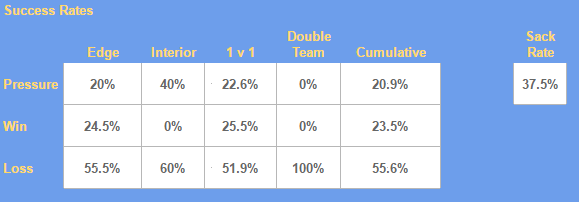
By all measures, Ingram had an incredible 2015 season. He had been swiftly labeled a bust after his first three seasons in the NFL, over which he combined for 6 sacks in 29 games. Finally, four seasons into his career, Ingram seems to have figured it all out. His ability to beat his blocker, pressure the quarterback, and bring him to the ground were all exceptional in 2015.
His Pressure Rate of 20.9% is truly elite. Of the limited sample of players I have charted from 2015 Ingram’s 20.9% is the best of the bunch. It’s also the only one above 20%. Being able to directly negatively impact the offense one out of every five times you rush the quarterback isn’t anything to laugh at. Conversely, his Win Rate of 23.5% is average to just below average. It’s to be expected, though, that as you create pressure on a higher percentage of plays where you beat your blockers you’re going to simply “win” on a lower percentage. That’s a trade off that I would happily take.
Even more notable than Ingram’s improvement from his first three seasons into his fourth is his improvement from the first half of 2015 into the second half. A lot of that had to do with John Pagano finally allowing him to rush the passer rather than dropping him into coverage, but the Melvin Ingram we saw in Week 1 is not the same Melvin Ingram we saw in Week 17. It was throughout the course of the season that he found his place in the Charger’s defense. Before Week 8, Ingram had a Pressure/Win/Loss slash line of 15.2%/24.2%/60.6%. Those numbers are all well below average and place him right in line with Bruce Irvin, who was similarly misused in Seattle. However, for Week 8 and on his slash line improved to 23.2%/23.2%/53.7%. If those were his numbers over the full season, I think you could make the argument that he was a top 15 EDGE rusher in 2015.

The ways Ingram won are just as impressive as how often he won. He showed an exceptionally well rounded repertoire of pass rush moves, especially for how dominant his natural tools can be. Ingram could have substantial success if he only relied on those natural tools. However, mixing in counter moves such as an inside rip, swim, and spin to compliment the bend, bull rush, and initial jump he already has is what made his 2015 great. It’s also what makes me think the success that he saw over the last 8 games of 2015 will be translated into 2016.
Not only is his advanced repertoire of pass rush moves encouraging, but he also rarely had his success due to coverage or being left unblocked. They account for only 12.8% of his successes. The only player with a lower figure is Olivier Vernon at 7.8%. The lower the percentage of successes that isn’t actually due to the player’s merit, the more translatable that success is into future seasons.
Ingram having his first successful season at 26 years old defies what we know about EDGE rushers having success later in their careers, but it makes sense why he was able to bend the rules. The constant injuries that Ingram faced made it difficult for him to develop the natural talent that he has always had. Ingram broke one rule, but he provided a prime example for another. It would have been easy to discount that Ingram would ever have success after his first three seasons in the league. EDGE rusher evaluation is an exercise in patience rather than one about making snap decisions. Melvin Ingram, at least as of right now, is proof of that.
]]>Force Players is an athletic threshold based off of combine performances of pass-rushers that I’ve been working on since 2011. It isn’t the end all be all for edge defenders, but it’s close. It works as a healthy risk analysis, based on a sample of the 2005 through 2015 draft classes.
I often get asked if Player X is a Force Player or not, so I decided to make a definitive list for the coming 2016 season, now that the draft is over. I included the the Prodigy status of individual pass-rushers and what their peak sack average is, taken from Force Players: Sack Study.
We can say that there’s a fairly definitive line for success for pass-rushers who are X athletic with X production at X age.
The trend is pretty simple, In just about every case, Force Players double non-Force Players in sack output of their best three seasons when split by round. Judging by the number of active players in each category and the success of pass-rushers from the 2015 and 2014 draft classes, the numbers should only rise over the next few years.
Notes:
- Players who are 23-year-olds or younger were highlighted in the “Age” column.
- Players who have posted fewer than three seasons in the NFL were highlighted in the “Average” column.
- Players who began their NFL careers at the age of 24 or older were automatically placed in the non-Prodigy categories, but have been noted with “No-Age” in the “Prodigy Pass” column.
If this trend keeps up to the standard of the last decade or so, the players in make or break seasons are:
- Force Players: Frank Clark (Seattle), Randy Gregory (Dallas), Shaq Riddick (Arizona) and Trevor Bates (Indianapolis)
- Mid Tiers: Bud Dupree (Pittsburgh) and Stephen Weatherly (Minnesota)
Force Players need to hit a four-sack single-season mark before they begin a regular season as 24-year-olds before they’re on track for success, while Mid Tiers need to hit a 5.5-sack single-season mark.
Here are players who have similar athleticism when compared to best pass-rushers in the league, but are 22 years old or younger:
- Force Players: Shaq Lawson (Buffalo), Robert Nkemdiche (Arizona), Danielle Hunter (Minnesota-already passed Prodigy filter), Dean Lowry (Green Bay) and Tyrone Holmes (Jacksonville)
- Mid Tiers: Jonathan Bullard (Chicago)
One player, Bronson Kaufusi, is over the age of 23, and begins his rookie season with elite athleticism.
]]>Round 1 – Pick 25: Artie Burns, CB, Miami (FL)
The Player: Artie Burns is actually a pretty good cornerback. He’s just a little bit, or a lot bit, of a work in progress (especially in the coverage schemes the Steelers run, but more on that later). What stands out the most when watching Burns is his ability to defend the catch point. He is tough and physical, without drawing many penalties, which makes life very tough on the receiver. On top of that, he has exceptional body control in the air and hands like a receiver. Burns has a nose for the ball and he is exceptional coming downhill to defend the run or bring receivers to the ground after the catch.
On another note there is rarely a rarely a comeback route where Burns won’t get lost. It should be very exciting watching him give up 8 receptions and 100 yards to every receiver he covers next year. He is naturally fit to play as a press-man cornerback due to his length, strength, and long speed, but he currently lacks the nuance to do so at a high level. Even though his natural abilities could give wide receivers fits, he too often allows the wide receiver to get a release where he is supposed to be preventing them from going. He has lots of ability and he could very well end as a very good player, but it will undoubtedly take time and care.
The Pick: Burns is a good player and a high upside pick with an uncertain future is easier to justify in this weak draft than most. He is, however, much better suited for the second round than the first. Adding the fact that there were two very, very good nose tackle prospects in Kenny Clark and Vernon Butler on the board when the pick was made only makes it worse. I understand the urgency to take a cornerback in the first round, but reaching is never the way to go.
The Fit: This is hands down the worst aspect of the pick. Burns played almost exclusively press-man and cover 3 at Miami and his skill-set is best fit to do the same in the NFL. I think he can play in the Steelers’ cover 2 coverage, but you’re essentially punting the first few years. The complexity of the cover 2 that Pittsburgh runs and the fact that Burns has to learn it from scratch will keep him off the field, at least in an effective matter, early on in his career.
That alone is enough to make this pick a head-scratcher when the center of your franchise is 34 years old and probably only has 3 years left in him.
Round 2 – Pick 50: Sean Davis, DB, Maryland
The Player: This is one of my favorite players in the draft. I loved Eric Rowe last year and Davis is an almost mirror image of him, especially athletically. That athleticism is what gives Davis the ability to play multiple positions in the defensive backfield, which is probably one of the things the Steelers like about him most. On top of his athleticism and versatility, Davis also has very quick and light feet, although they aren’t very refined. Even in his first year at cornerback he showed that he has at least a decent grasp on the mental part of playing on the boundary.
Davis is a lot better defending what is in front of him at this point than he is defending what is behind him, though. That is a very good thing when you talk about run defense and minimizing gains from short passes, but it becomes a question when projecting him to safety. It even affects him when covering deep pass plays at cornerback. Along with Artie Burns, Davis is another high upside pick at corner, but unlike Burns he seems to have enough ability to see the field immediately in Pittsburgh.
The Pick: The talent in this draft fell off hard after 30 or so players, so getting a player of Davis’ caliber in the late second round could be viewed as somewhat of a steal. Ideally the pick would have been a defensive tackle here or a true safety rather than a cornerback with some safety ability, but I can’t argue when one of my favorite players in the draft is the pick.
The Fit: The one thing I hate about this pick is that the Steelers seem to want to start Davis off at safety. That seems like a popular place for draft analysts to slot him, but I don’t think it could be farther off. Like I mentioned, Davis is a lot better going forwards than he is backwards. He’s a lot more eager to come forward than drift backward, also. If he can’t clean that up by the time he sees major playing time at safety then there will be a lot of deep touchdowns in Pittsburgh next year.
Round 3 – Pick 89: Javon Hargrave, DL, South Carolina State
The Player: Hargrave was a man among boys in Division I-AA at South Carolina State. He would have been nearly unrivaled athletically had he been a defensive lineman in the FBS, let alone the FCS. He is one of the only interior defensive line #ForcePlayers# in the draft and that athleticism clearly translates to outstanding pass rush ability. Hargrave is super explosive and crazy flexible for a 305 pound player. He can beat interior offensive by running over them, by them, or around them as a pass rusher. He’s also surprisingly diverse in his pass rush moves for a player who didn’t need to be in order to have success at the lower levels.
Hargrave does struggle some as a run defender, though. He’s not terrible and he should grow in this area over time, but he’s not nearly as adept against the run as he is against the pass. He probably won’t be doing much run defending in Pittsburgh, anyway, as he is a one-gapping 1-tech or 3-tech rather than a two-gapping nose tackle.
The Pick: Going into the draft I was hoping to come out of the first 3 rounds with a cornerback, safety, and nose tackle. Hargrave definitely isn’t the starting nose tackle the Steelers need, but I am ecstatic about this pick nonetheless. Anytime you can get a top 40 player at the end of the 3rd round you should do it, especially if it’s an interior penetrating (nh) defensive lineman. Interior pass rush is the king on defense in today’s NFL.
The Fit: Don’t get yourself wrapped up in the fact that Hargrave likely won’t ever be a starter in the 3-4 defense that the Steelers run. Instead, focus on what he will bring to the team on passing downs. He immediately becomes a threat that can rotate with Heyward and Tuitt on passing downs. All three will probably even be on the field simultaneously at times. Hargraves pass rush ability will immediately help out the EDGE rushers who struggled so mightily last year as well as the coverage on the back end.
]]>An area much less talked about is draft-day trades. It’s easy to focus solely on the player that a team moved up for, but remember… those mid-to-late round picks can end up being all-pro players (Russell Wilson, Josh Norman, Richard Sherman, etc.). Teams certainly shouldn’t be giving up their resources without a compelling reason to do so.
So, when trading up, how much is ‘too much’ ? The NFL trade value chart provides one vehicle to determine that. As I wrote about earlier this week, teams are definitely using the chart as a framework for their trades, with the exceptions tending to come in the top six picks of the draft.
Let’s see how teams fared with this year’s Round 1 Trades. All point values are according to the trade value chart:
Titans trade #1 overall pick to Rams; Browns trade #2 overall pick to Eagles
See my article from earlier in the week for the value breakdowns of these two trades (hint: the teams trading down won in a landslide).
Browns trade #8 overall pick to Titans
The Trade:
Browns receive:
- 15th overall pick (1050 points)
- 76th overall pick (210 points)
- 2017 2nd round pick (430 points – used middle of the round since we don’t know true location)
- => Total value: 1690 points
Titans receive:
- 8th overall pick (1400 points)
- 176th overall pick (21 points)
- => Total value: 1421 points
Trade Value Chart Says:
The Titans gave up 269 points, which corresponds to the 64th overall pick (Round 3, Pick 1).
Jack Says:
The Titans definitely gave up some value here. In my previous article, I identified ~100 points (equating to a 4th round pick) as the threshold below which teams didn’t seem concerned (in 85% of draft pick trades since 2011, the two sides of the trade were within 100 points of each other in terms of the trade value chart). I get that the Titans wanted/needed a tackle to protect Marcus Mariota, and Jack Conklin is a solid prospect, but they paid a significant price. When you aggregate this trade with their trade down from #1, it’s still an easy victory; however, the smart move probably would have been to stay put and draft the best player on the board at #15.
Bucs trade #9 overall pick to Giants
The Trade:
Bucs receive:
- 11th overall pick (1250 points)
- 106th overall pick (82 points)
- => Total value: 1332 points
Giants receive:
- 9th overall pick (1350 points)
- => Total value: 1350 points
Trade Value Chart Says:
Just about even. A 20 point differential is equal to a 6th round pick and is well below the threshold of 100 points.
Jack Says:
An even trade, and more evidence that the trade value chart is being used to frame negotiations. The Giants moved up to get their guy, while the Bucs had a few choices they liked and were content to move back a bit.
Redskins trade #21 overall pick to Texans
The Trade:
Redskins receive:
- 22nd overall pick (780 points)
- 2017 6th round pick (15 points)
- => Total value: 795 points
Texans receive:
- 21st overall pick (800 points)
- => Total value: 800 points
Trade Value Chart Says:
Just about even again. A 5 point differential is worth only a distant 7th round pick and is again well below the 100 point threshold.
Jack Says:
What do you know, another trade that molds into the trade value chart almost exactly. It makes sense for both teams and there isn’t a clear winner.
Seahawks trade #26 overall pick to Broncos
The Trade:
Seahawks receive:
- 31st overall pick (600 points)
- 94th overall pick (124 points)
- => Total value: 724 points
Broncos receive:
- 26th overall pick (700 points)
- => Total value: 700 points
Trade Value Chart Says:
Again, a fair deal. 25 points equates to a late 5th-rounder and is below our 100 point threshold.
Jack Says:
Although this trade is a wash value-wise, I’ll give the ‘winner’ nod to the Broncos. Unlike the Rams and Eagles, who were so desperate for QB help that they panicked and mortgaged their futures, the Broncos stayed cool. They resisted the urge to trade for damaged goods like Colin Kaepernick and Sam Bradford, and they waited late enough in the draft until they could move up just a few spots and secure a solid QB prospect without sacrificing value. I don’t know if Paxton Lynch will pan out, but this was a very savvy move by GM John Elway nonetheless.
Chiefs trade #28 overall pick to 49ers
The Trade:
Chiefs receive:
- 37th overall pick (530 points)
- 105th overall pick (84 points)
- 178th overall pick (20 points)
- => Total value: 634 points
49ers receive:
- 28th overall pick (700 points)
- 249th overall pick (1 point)
- => Total value: 661 points
Trade Value Chart Says:
Another trade that closely matches with the trade value chart. The 27 point difference corresponds to a mid 5th-round pick.
Jack Says:
This is perhaps the most interesting trade of the evening for me. The ESPN announcers chastised San Francisco for moving up to select Joshua Garnett, and after learning that the 49ers selected a Pac 12 prospect to join Chip Kelly, that was my initial reaction, too. However, from a value standpoint, the 49ers got the better end of the deal (albeit slightly). My conclusion is that this trade was more about the Chiefs being desperate to trade down rather than the 49ers being desperate to trade up. It was rumored that the Chiefs wanted Paxton Lynch, so after getting sniped by Denver, they were probably looking to move down no matter what.
]]>Love #Packers pick of Kenny Clark. High-energy NT. Former wrestler. Runs down RBs in pursuit.
— Evan Silva (@evansilva) April 29, 2016
The #Packers unfortunately get one of my favorite DL in Kenny Clark. His #RAS is good,not great,but his tape is too pic.twitter.com/49nr4MKAac
— Kent Lee Platte (@MathBomb) April 29, 2016
2016 NFL Draft, Twenty Seventh Overall Selection: The Green Bay Packers select UCLA DT Kenny Clark. pic.twitter.com/Y7HvcwqHFE
— Kyle Crabbs (@NDTScouting) April 29, 2016
The #Packers select UCLA DT Kenny Clark (6-3, 314). 164 career tackles (20.5 for a loss) with seven sacks in 39 games (29 starts)
— Wes Hodkiewicz (@WesHod) April 29, 2016
Kenny Clark doesn't turn 21 until October
— Ian Kenyon (@IanKenyonNFL) April 29, 2016
Kenny Clark recorded one bull-rush pressure for every 23.8 pass-rush snaps, the second-best rate for interior defenders in this class.
— Pro Football Focus (@PFF) April 29, 2016
I was surprised Kenny Clark didn't go even higher.. Great leverage guy. Great HS wrestler like another Packers DL Mike Daniels.
— Bruce Feldman (@BruceFeldmanCFB) April 29, 2016
Clark's big 2015 included a monster effort versus UW, where he posted a sack, 5 hurries, and 6 run-stops. He had 7 sacks for the season.
— Pro Football Focus (@PFF) April 29, 2016
Kenny Clark's +15.7 against Arizona was the highest graded game for any interior defender in the 2015 FBS season.
— Ben Stockwell (@PFF_Ben) April 29, 2016
From earlier this week: As Kenny Clark embarks on an NFL future, a murder conviction keeps father in prison #GBpick https://t.co/ocikWh9zje
— Rob Demovsky (@RobDemovsky) April 29, 2016
One thing that stands out about Clark is the number of tackles he makes, 75 last season. That's an insanely large number for a nose tackle.
— Brian Carriveau (@BrianCarriveau) April 29, 2016
Thompson says #Packers were "very excited" to get Kenny Clark at No. 27. "We weren't sure we'd have that opportunity."
— Jason Wilde (@jasonjwilde) April 29, 2016
Asked Ted Thompson where he sees Kenny Clark lining up on DL: "We move those guys all around. I can't tell you. We just draft him."
— Ryan Wood (@ByRyanWood) April 29, 2016
Thompson said he took "a few calls" to trade back, but decided to stand pat and draft Kenny Clark.
— Ryan Wood (@ByRyanWood) April 29, 2016
No big surprise GB grabbed UCLA DT Kenny Clark. Since Ted Thompson took over GB in 2005, he's taken 5 UCLA players, more than any school.
— Adam Schefter (@AdamSchefter) April 29, 2016
Kenny Clark joins Mike Daniels as former wrestlers on the d-line. Mike Trgovac also was a former state champion #Packers
— Wes Hodkiewicz (@WesHod) April 29, 2016
Clark: "I feel like I'm very versatile. I can do whatever they ask me to do, whether it's play nose, 5, 3. I can do anything."
— Ryan Wood (@ByRyanWood) April 29, 2016
Clark said he's already Facetime'd with Datone Jones since #Packers picked him. Brett Hundley has called, too. Green Bay is new Hollywood.
— Ryan Wood (@ByRyanWood) April 29, 2016
Kenny Clark said the main two players he models his game after are Haloti Ngata and Geno Atkins. Speed and power. Two interior pass rushers.
— Ryan Wood (@ByRyanWood) April 29, 2016
Kenny Clark will wear #97 for the #Packers.
DT Christian Ringo moving to #99. pic.twitter.com/aytThemveE
— Green Bay Packers (@packers) April 29, 2016
…Kenny Clark has grown man strength. Truly believe he has the power, body, athleticism and skillset to be a Fletcher Cox claiber of player
— Ben Fennell (@BenFennell_NFL) April 29, 2016
4thQ under :20sec and UCLA up 16pts.. Love the effort by Clark in this situation! @KCBoutThatLife pic.twitter.com/gP8VDeDdCx
— Ben Fennell (@BenFennell_NFL) April 29, 2016
Jason Spriggs #48, OT, Indiana
Packers traded up directly in front of Bears to draft Indiana OT Jason Spriggs.
— Adam Schefter (@AdamSchefter) April 30, 2016
Not just this draft, new #Packers OT Jason Spriggs is one of the most athletic OT since 2000 via #RAS. pic.twitter.com/vxtzER0ySV
— Kent Lee Platte (@MathBomb) April 30, 2016
Jason Spriggs 97.7 pass blocking efficiency against Power-5 opposition was the 6th-best mark among OTs in this NFL draft class
— PFF Draft (@PFF_College) April 30, 2016
In 2014 and 2015, Spriggs yielded a total of four sacks, four hits, and 17 hurries on 889 pass-block ing snaps. pic.twitter.com/K75sHmKscm
— Pro Football Focus (@PFF) April 30, 2016
Welcome Spriggs! I chew skoal wintergreen and like my coffee 2 creams, 2 sugars.
— TJ Lang (@TJLang70) April 30, 2016
In 2015 with the Hoosiers, Jason Spriggs allowed just two sacks in 431 pass attempts. #Packers got a good one.
— Michelle Bruton (@Michelle_NFL) April 30, 2016
"I'm worried about all things at all times." Ted when asked if he was worried about another team in the division taking Spriggs.
— Aaron Nagler (@AaronNagler) April 30, 2016
Kyler Fackrell #88, EDGE/LB, Utah State
Kyler Fackrell's 15.7 pass rush productivity score ranked 3rd among 3-4 OLBs in the NFL Draft
— PFF Draft (@PFF_College) April 30, 2016
Fackrell will be 25 in November
— Chris Nicolaou (@CnicNFL) April 30, 2016
Packers fans, meet Kyler Fackrell, the No. 7 edged defender on PFF's draft board: https://t.co/0jg5RUfAx5 pic.twitter.com/ceKVLbJBEb
— Pro Football Focus (@PFF) April 30, 2016
Kyler Fackrell had 5 sacks, 15 TFLs last season, his first back from missing almost entire 2014 with torn ACL. Should be stronger in 2016.
— Ryan Wood (@ByRyanWood) April 30, 2016
Fackrell wants to gain 10 pounds to 260: "Speed kills. I always try to win with speed first, but I need to incorporate upper-body moves."
— Ryan Wood (@ByRyanWood) April 30, 2016
Blake Martinez #131, LB, Stanford
131 #Packers Blake Martinez LB Physical w/ good tackling technique. 2 down thumper. Not very explosive. Slow twitch player.
— Shane P. Hallam (@ShanePHallam) April 30, 2016
The highest 2015 coverage grade in among linebackers in this draft class belongs to Stanford's Blake Martinez, +10.9.
— PFF Draft (@PFF_College) April 30, 2016
My favorite LB Blake Martinez stat: in 2015, he had 84 MORE tackles than the team’s second-leading tackler (141 tackles). #Packers
— Dane Brugler (@dpbrugler) April 30, 2016
Blake Martinez is a classic Will ILB, ran a 4.62-second 40 at Stanford's pro day. Expect #Packers to use him as nickel and dime linebacker.
— Ryan Wood (@ByRyanWood) April 30, 2016
Blake Martinez ran a 4.20-second, 20-yard shuttle at combine, second fastest of all ILB. Reggie Ragland's was 4.28. Scobby Wright was 4.47.
— Ryan Wood (@ByRyanWood) April 30, 2016
Blake Martinez said his mom always told him through pre-draft he'd be with #Packers. What'd she tell him today? "Moms are always right."
— Ryan Wood (@ByRyanWood) April 30, 2016
Seale on Martinez in nickel: at stanford he played on 3rd down, also can play special teams.
— Pete Dougherty (@PeteDougherty) April 30, 2016
Dean Lowry #137, DL, Northwestern
Dean Lowry recorded 1 bullrush pressure for every 25.9 pass rush snaps, the 3rd-best rate by an edge rusher in this draft class
— PFF Draft (@PFF_College) April 30, 2016
Northwestern DE Dean Lowry is 6-5 3/4, 296 pounds with 31-inch arms and 76 1/8 wingspan. Frame for 5-tech end, arms to play 3-tech tackle.
— Ryan Wood (@ByRyanWood) April 30, 2016
Dean Lowry led the FBS over the past two seasons with 15 batted passes
— PFF Draft (@PFF_College) April 30, 2016
Can't wait for everyone to talk about how Dean Lowry is "tough", "coachable" and a "worker" . AKA = white guy they didn't watch
— Matt Miller (@nfldraftscout) April 30, 2016
Wolf said Dean Lowry can play inside as a 3-tech DT, outside as a 5-tech end, even stand up some as an OLB.
— Ryan Wood (@ByRyanWood) April 30, 2016
Trevor Davis #163, WR, California
#Packers fans should be really excited about Trevor Davis. An Emmanuel Sanders type. Told about him late, ended up with a 4th grade from us.
— Eric Galko (@OptimumScouting) April 30, 2016
Trevor Davis continues Packers' trend of going for great athletes. 85th percentile for his position by SPARQ.
— Jason B. Hirschhorn (@by_JBH) April 30, 2016
Trevor Davis ran 4.42 w/ a 38.5" vertical. @chad_reuter included him in his "better pro than college players" piece: https://t.co/NGPGB5OUM7
— Zach Kruse (@zachkruse2) April 30, 2016
The @PFF numbers aren't great on Davis, but he had a higher Yards Per Route Run than Laquon Treadwell, and only 2 drops on 53 targets.
— Zach Kruse (@zachkruse2) April 30, 2016
Trevor Davis had the 5th fastest 3 cone drill of any wide receivers in the last 5 years at the combine
— Cody Bauer (@CBauerNFLDraft) April 30, 2016
Davis on why left U of Hawaii: to go to a bigger school, a bigger stage.
— Pete Dougherty (@PeteDougherty) April 30, 2016
Seale on WR Davis: Speed. I'm an old Raider, speed kills. Once you have speed that's all u need. Very big hands, can catch the football.
— Pete Dougherty (@PeteDougherty) April 30, 2016
Kyle Murphy #200, OT, Stanford
Per @PFF, Kyle Murphy only gave up 13 pressures last year. PFF ranked him as the 7th best OT, with 3rd round grade.
— Zach Kruse (@zachkruse2) April 30, 2016
Murphy is 6-7, 301 pounds. Was first team all-Pac12. Started at left tackle last year, right tackle the year before that.
— Tom Silverstein (@TomSilverstein) April 30, 2016
]]>Stanford OL Kyle Murphy said 60 or 70 percent of teams see him as offensive tackle, but others see him as a guard. Gives #Packers options.
— Ryan Wood (@ByRyanWood) April 30, 2016
Based on athletic potential, you can tell a lot about pass-rushing prospects.
Force Players is an athletic threshold based off of combine performances of pass-rushers that I’ve been working on since 2011. It isn’t the end all be all for edge defenders, but it’s close. It works as a healthy risk analysis, based on a sample of the 2005 through 2015 draft classes.
Using Force Players to split up different categories of pass-rushers, you’ll find that athletic draft prospects selected early in the draft are about twice as productive at their peaks as their counterparts.
The trend is pretty simple, In just about every case, Force Players double non-Force Players in sack output of their best three seasons when split by round. Judging by the number of active players in each category and the success of pass-rushers from the 2015 and 2014 draft classes, the numbers should only rise over the next few years.
Using Force Players to split up different categories of pass-rushers, you’ll find that athletic draft choices selected early in the draft are eight times more likely to still be on their original team by their sixth year in the NFL (equivalent to seeing a second contract after a fifth-year option for this generation’s first-round picks.)
7.1 percent of those non-Force Players were still with their original franchise during their sixth NFL season. You’re 8.32 times more likely to still be on your original franchise in your sixth season in the league if you’re a first- or second-round Force Player compared to a non-Force Player.
You can also essentially pin down if a pass-rusher is or isn’t go to “make it” in the league by his productivity relative to his athleticism at the age of 23.
We can say that there’s a fairly definitive line for success for pass-rushers who are X athletic with X production at X age.
So how does that help us view this draft class? Specifically looking at the 2016 pool, using first-round numbers alone (since 2005), we can claim that:
- There’s a 61 percent chance that Shaq Lawson is going to average around 13 sacks in his three best seasons in the statistic (about Shawne Merriman or Clay Matthews), while there’s a 39 percent chance that he’s going to average around 4.5 sacks in his three best seasons (about Manny Lawson.)
- There’s a 82 percent chance that Joey Bosa and Leonard Floyd are going to average around three sacks in their three best seasons in the statistic (about Derrick Harvey), while there’s an 18 percent chance that they’re going to average around 11 sacks in their three best seasons (about Chandler Jones.)
- Leonard Floyd, who is turning 24 years old before Week 1, should have been producing in the NFL at a seven-sack rate last season to be conducive to next level success, but he was instead playing as an off the ball linebacker in college football in 2015.
As pure pass-rushers, there odds seem to be against San Diego’s Joey Bosa and Chicago’s Leonard Floyd, but in favor of Buffalo’s Shaq Lawson.

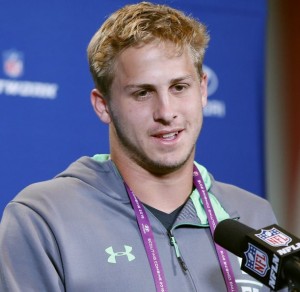
Name: Jared Goff
Position: Quarterback
Scouting Report: From a physical point of view, Jared Goff has everything you want in a QB. He’s a tall 6’4, a bulky 205 pounds, and he just has that football look about him. You see him and you can just imagine him saying “Yeah, I like to sling the rock and skateboard and I love when my mom buys pizza rolls.” But I’m afraid that’s all there is to him. First of all, he’s an idiot. Second of all, I can’t tell if he emotionally neglects his puppy or if his puppy is constantly thinking about how horrible his NFL career will be.


Pros
- He’ll likely get drafted by the Rams and become really popular because of this
Cons
- His coach will likely be Jeff Fisher, guaranteeing a 7-9 record.
Rating: Trash
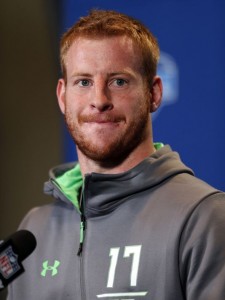
Name: Carson Wentz
Position: Eagles Fan Life Ruiner
Scouting Report: I call this guy Carson Wince, because when I watch him play, can you guess what I do? This guy sucks. Typically, I don’t watch film to rate my prospects. I prefer to use their social media accounts to properly get a feel for their future success or lackof.
and well. Wow.
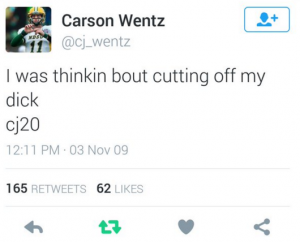
“Well hey, that was in 09! He was a teenager!” Ok. True. But I never thought about cutting off my dick as a teenager. Have you?
Pros
- Wanting to cut his dick off shows bravery
- Causes Ben Natan dread since he is Ben Natan
Cons

- This picture looks stupid. Carson Wentz looks like an idiot. Why are you wearing the ducks? What did the ducks do to you, man? Are you more passionate about destroying lives in the duck community over football?
- He sucks
Rating: Trash

Name: Joey Bosa
Position: Defensive End
Scouting Report: Bosa is an interesting prospect, and for a while, was considered the best pass rusher in the draft.
Pros
- Bosa has been linked to “party drug” rumors. Which explains this pic:
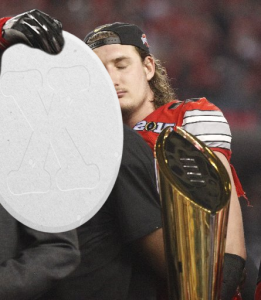
Cons
- Really awkward guy.
- Talks like he’s a hostage but he can’t tell the person he’s talking to that he is one or he’ll get shot.
- Makes posts like this:

I don’t have to explain much more.
Rating: Trash
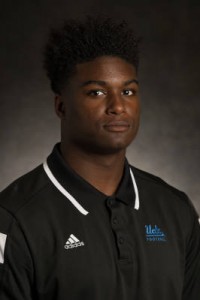
Name: Myles Jack
Position: Linebacker
Scouting Report: Mylse Jack is a good player. He shows a lot of speed and athletcism for his size, and his insticts on the field are superb. Unfortunately, he’s actually an 80 year old man.

Pros
- Random nerds on draft twitter dislike him
Cons
- He belongs in a nursing home
Rating: Trash
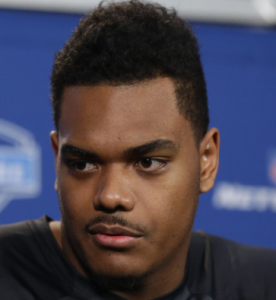
Name: Ronnie Stanley
Position: Offensive Tackle
Scouting Report:
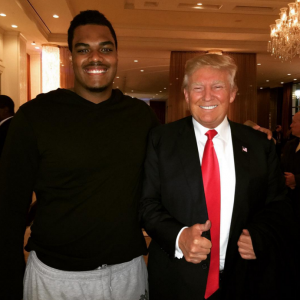
I…what?
Rating: Trash
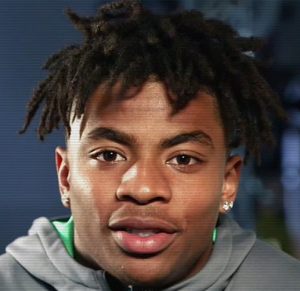
Name: Vernon Hargreaves III
Position: Cornerback
Scouting Report: Vernon Hargreaves is often considered the 2nd best cornerback in the draft behind Jalen Ramsey. That’s not a knock, as Ramsey is a very good cornerback prospect.
Pros
- Is in a rap duo.

Cons
- Once got upset at someone for not inviting him to see “the minions movie,” showing his lack of judgment skills.
- Said he likes that the NFL passes more because it means he gets more chances to get burned. I appreciate that honesty.
Rating: Solid

Name: DeForest Buckner
Position: Defensive Lineman
Scouting Report: Was very productive his last year at Oregon.
Pros
- Chops wood in his spare time, which is some suspect shit.
- Will have an easy transition if people ever decide to mic him up, since he’s already used to snitching and probably cooperating with police with a wiretap.
Cons
- Here’s a picture of DeForest Buckner where he appears to be snitching to the cops.
 “It was him officer. He was the one who said you look like a poopface behind your back”
“It was him officer. He was the one who said you look like a poopface behind your back”
- Pete Prisco loves him, hurting his value.
- Going off of his name, he probably loves unregulated capitalism and air pollution.
Rating: Trash
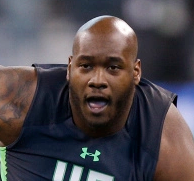
Name: Laremy Tunsil
Position: Offensive Lineman
Scouting Report: Laremy Tunsil is big, strong, and probably the best offensive lineman in the draft.
Pros
- Possibly threw Robert Nkemdiche out of a window.

Cons
- Didn’t throw him out of a window a second time for snitching
Rating: Solid
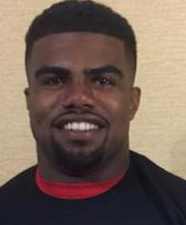
Name: Ezekiel Elliott
Position: Running Back
Scouting Report: Ezekiel Elliot on film is often compared to Ladainian Tomlinson.
Pros
- Once demanded he get more carries, showing he’s all about himself and not with that teamwork bullshit
- The bottom half of his face kinda looks like Kanye West’s
Cons
- Linked to party drug rumors just like his roommate Bosa
-
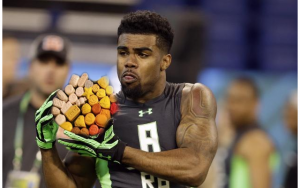
Rating: Trash
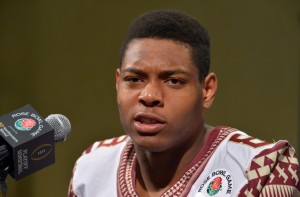
Name: Jalen Ramsey
Position: Cornerback
Scouting Report: Jalen Ramsey is very good on the field. While you’re watching him, it seems he’s always near the ball. Unfortunately, looking good on the field has nothing to do with future success. It’s all about random pics you find on the internet involving prospects.
Pros
- Once got suspended for being too rough in practice
- Said “I didn’t know the Rams loved me that much” when he heard about the Rams trading up to #1. Naive little bastard.
Cons
- As of right now, deactivated all of his social media. Coward. But possibly smart.
- Doesn’t have a lot of interceptions, which is the only stat that matters for cornerbacks if you’re in a barbershop
- Is often called a safety too. Can’t make up his mind smh.
Rating: Solid
That’s all for now. Hope your favorite team drafts one of these trash players!
]]>